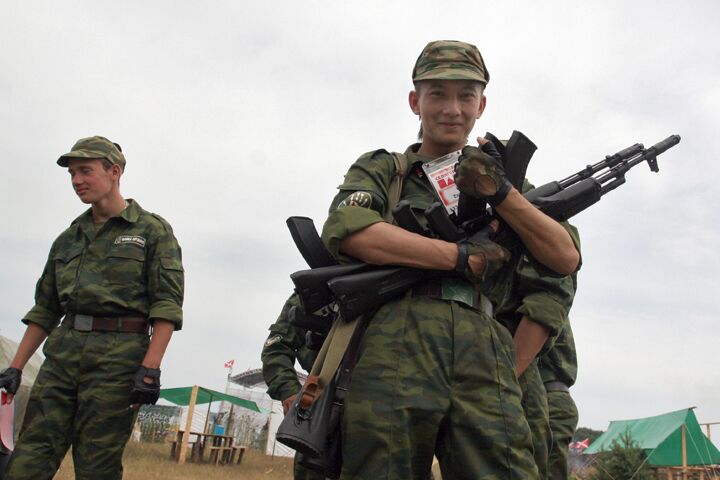
Youth: Putin’s New Political Weapon
Russian President Vladimir Putin is utilizing a proven propaganda tool to perpetuate his legacy. The tool: nationalist youth movements. Nashi, the largest of these movements, has grown to 10,000 members and 200,000 other participants.
Many familiar with World War ii history say the Nashi movement is eerily similar to the Nazis’ Hitler Youth.
Nashi emerged in Russia soon after the Ukraine’s “Orange Revolution” in 2004, an election crisis that finally ended with pro-Western leader Viktor Yushchenko taking the presidency, a development the Kremlin was less than enthused about. However, the Ukraine’s political revolution furnished all kinds of lessons, not the least of which was the power and influence of the young vote. Yushchenko was successful largely because he had the support of thousands of the Ukraine’s young adults—men and women who not only voted for him, but who also hit the streets in protest when the opposition tried to taint the election.
As a firsthand witness to this demonstration of the power of youth, the Kremlin reacted quickly to ensure similar pro-Western, anti-Putin movements did not take root in Russia. “Nashi, which translates as ‘ours,’ has since its creation two years ago become a disciplined and lavishly funded instrument of Putin’s campaign for political control before parliamentary elections in December and a presidential election next March” (International Herald Tribune, August 8; emphasis mine throughout).
Nashi, together with a growing number of similar youth movements, has become a political weapon in the Kremlin’s hands. “All of the Kremlin youth organizations in reality have two functions,” Ilya Yashin says. “The first is to demonstrate massive youth support for the president and the acting parties of power. The second is the organization of mass programs meant to prevent a Ukraine-style ‘Orange’ scenario from unfolding in our country.”
These youth movements are calculated programs designed to turn the hearts and minds of Russia’s young people over to their president. Loyalty to Putin is the number-one doctrine of Nashi. The president is practically worshiped as the man responsible for returning Russia to global power. In that sense, Nashi is very much Putin’s very own personality cult.
Though Nashi says it operates independently from the government, there is little doubt the group is in close cahoots with the Kremlin. Group leaders meet regularly with Putin’s top advisers, and Putin himself has called Nashi a member of his team. The Russian government is also one of the primary financiers of the Nashi movement. Additionally, Nashi members clearly receive preferential treatment from government agencies and state-run companies.
At heart, these youth movements are quintessentially nationalist organizations. They celebrate Russia’s nationalist history, particularly its Soviet and czarist eras, and denounce foreign intervention in any national affair. Nashi’s manifesto, written by Putin’s chief political advisor, Vladislav Surkov, states, “Today the United States on one hand and international terrorism on the other strive to control Eurasia and the whole world. … The task of our generation is to defend the sovereignty of our country as our grandfathers did 60 years ago.”
The mentality behind the manifesto is captured in the name of the movement. Nashi strictly translates to “ours,” but in Russian idiom it has a connotation of rivalry and can be translated as “our guys” or “our kind,” having a distinct tone of us-against-them nationalism. Putin’s influence over Nashi members, however, extends beyond the purely ideological; the group is also able to intervene in both internal and external affairs.
Nashi members are taught to organize mass actions and trained to break up opposition rallies. Last year, the group protested when a governor from the Perm region allowed a member of the opposition party to attend a youth conference. The governor quickly apologized after Nashi members picketed his offices. In April, Nashi members besieged the Estonian Embassy in Moscow, throwing rocks, blocking traffic and tearing down the Estonian flag. Nashi members even harassed Estonia’s ambassador in a news conference in May. The protest, permitted by the police, was a reaction to the Estonian government relocating a memorial to Soviet soldiers.
Perhaps the most telling feature of Russia’s nationalistic youth movements is the comparison many draw between them and Hitler’s Nazi Youth. The prime minister of Estonia, among others, has noted these alarming parallels. “Those nationalist youth organizations, Nashi and Young Guard, they are like the Hitlerjugend in Germany,” he said Tuesday. “We have to be worried.”
Hitler Youth was created in 1922 by the German chancellor as a paramilitary organization designed to groom young Germans in Nazi doctrine and to recruit and train future members of the Nazi Party. By 1933, the Hitler Youth movement had more than 100,000 members and had become a central part of Germany’s youth culture. By 1936, it had grown to 4 million members.
Though President Putin’s nationalistic youth movements are far from the size of Hitler’s Youth, they are cast in the same mold. Nashi, as well as the other groups, is a distinctly anti-Western, pro-Putin, patently nationalistic movement bent on perpetuating the disturbing legacy of Russian President Vladimir Putin.
